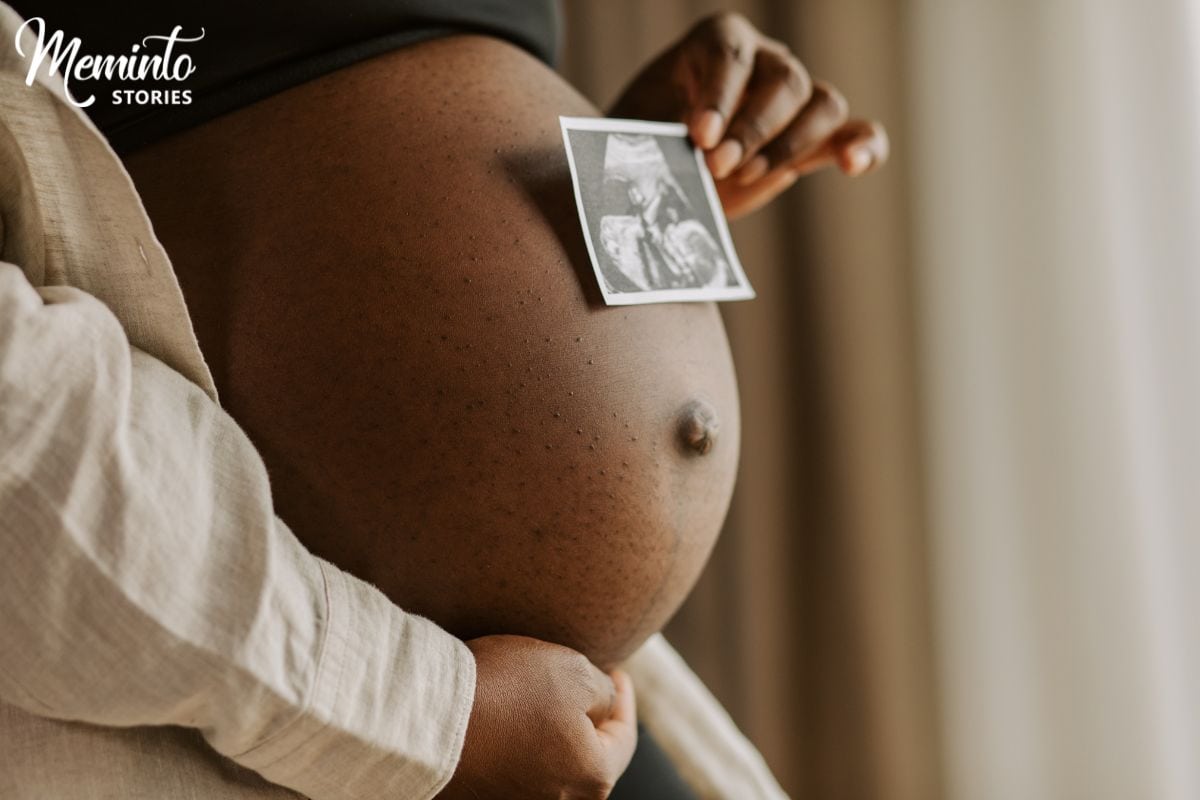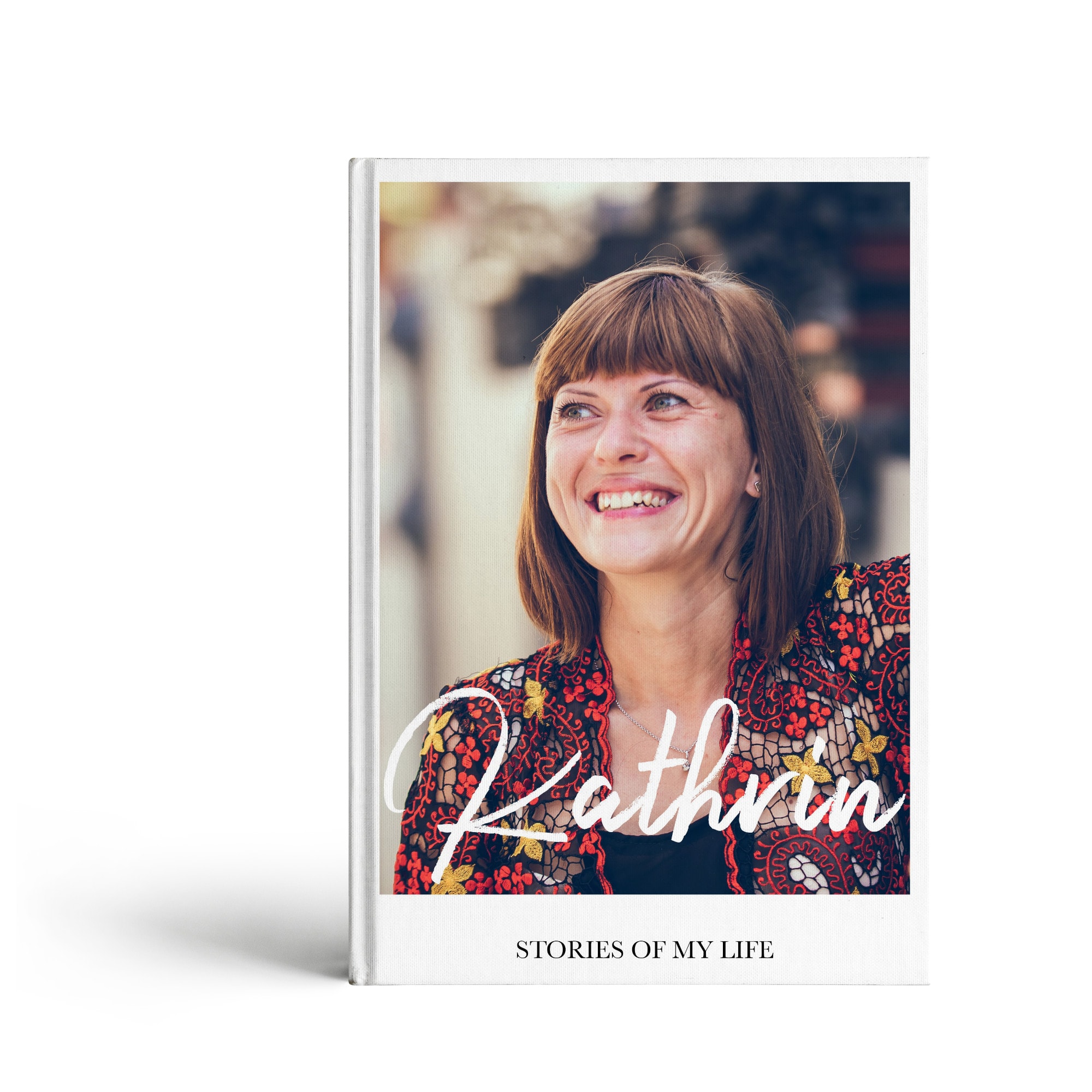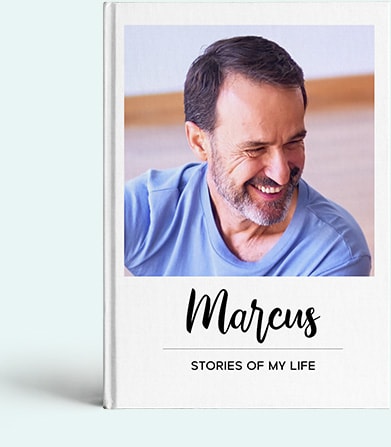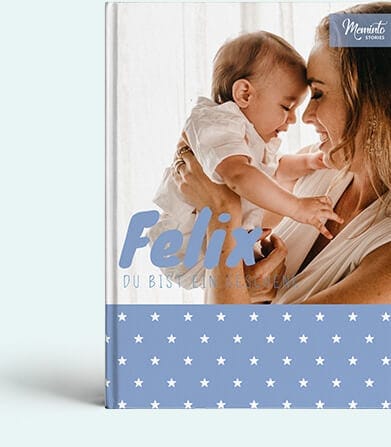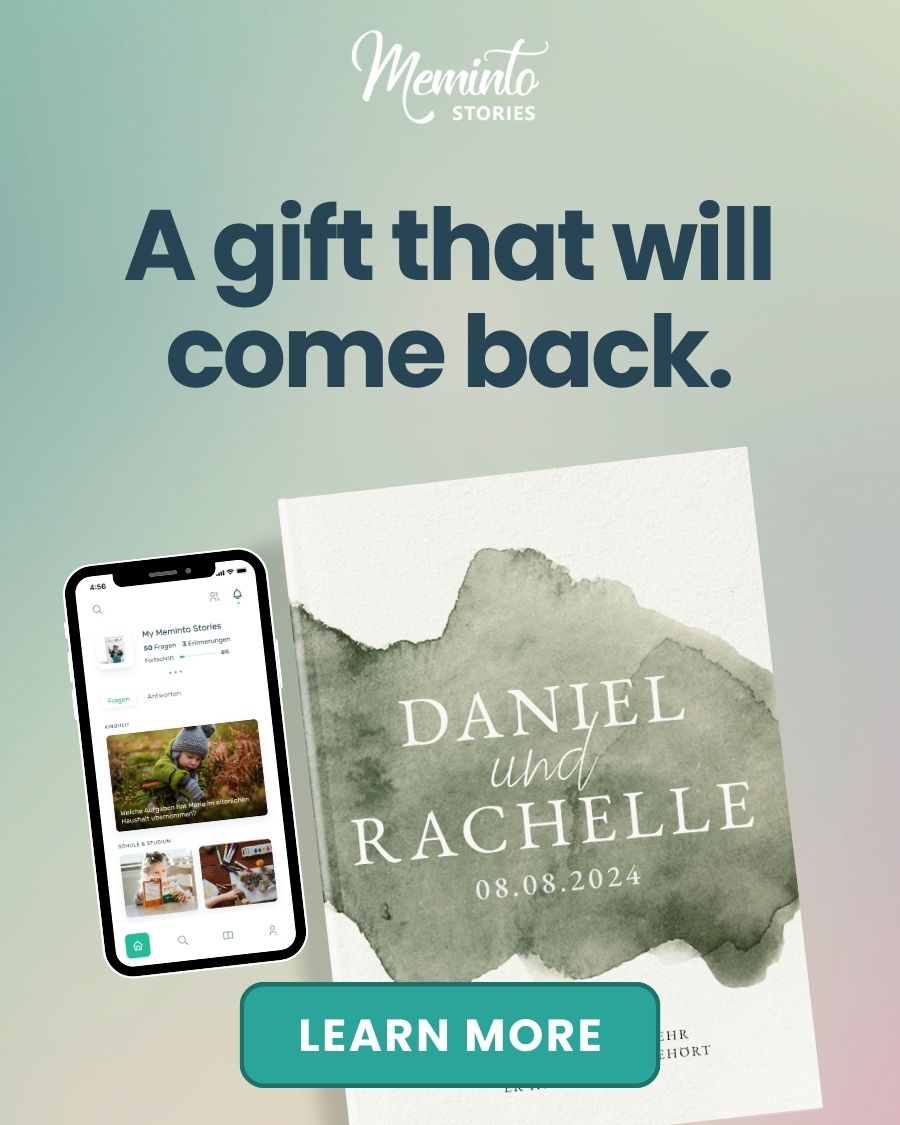There’s more to pregnancy than just a baby bump scrapbook filled with photos. It’s cravings that make no sense, the first kick that steals your breath, and 2 a.m. notes to the baby you haven’t met. If you only save photos, you’ll miss the feelings. Let’s fix that.
With Meminto Stories, I found a way to keep all my flashbacks of the first adventure with our child in a book. “Now we can cherish them forever,”
– Selma, UK
She discovered that regular baby books miss the real, life-changing experience of pregnancy. Many pregnancy memory book ideas highlight milestones and measurements. What about the emotional highs and lows, the surprises, and the small moments that make your journey unique?
In this guide, you’ll find 8 creative pregnancy memory book ideas that go beyond basic documentation. Each provides pregnancy journal prompts, DIY ideas, and tips for creating a keepsake book you’ll always treasure.
Why document your pregnancy journey beyond the baby book
Ask a new mom about pregnancy six months later and the edges have already blurred. That’s normal. Your brain is busy growing a human and prioritizes the big job over storing every little detail. All the more reason to capture what it felt like – now, not later.
Turns out, 81% of pregnant women feel their memory has gotten worse during pregnancy. You’re not losing your mind, though. Studies show that 80% of expecting mothers experience some form of memory loss or brain fog during this time.
Forgetting begins right away and can last for weeks or even months after giving birth. Some studies show these cognitive changes may last for at least six years after giving birth.
Those hormones that help you love your baby also affect your memory. Pregnancy decreases gray matter in brain areas responsible for thinking and memory. Your brain gets busy keeping this little one alive. It stops storing pregnancy details properly.
Can you remember what you wore last Wednesday? Probably not. Imagine capturing the highs and lows of pregnancy on just four hours of sleep with a crying newborn. In the third trimester, pregnant women often face sleep issues. Discomfort, frequent trips to the bathroom, and baby movements disturb their rest. This makes it hard to sleep.
Without writing things down, you lose so much. The ridiculous things your partner said when they first felt the baby kick. Which smells made you run from the room? (Crucial info for next time!) How did your belly look at 20 weeks versus 30? Those weird dreams that felt so important at 2 AM? Gone. The mix of excitement and terror at each doctor’s appointment? Forgotten.
Your pregnancy memory book captures more than just milestones. It saves not just what happened, but how everything felt when you were living it. While regular baby books start after birth, pregnancy journals preserve those nine months of anticipation, worry, wonder, and growing love for someone you haven’t even met yet.
Selma from the UK discovered this reality firsthand:
“With Meminto Stories I found a way to keep all my flashbacks of the first adventure with our child in a book. Now we can cherish them forever.”
Using pregnancy journal prompts, you can save both the facts and the feelings of those nine months before they slip away forever.
8 unique pregnancy memory book ideas you will cherish forever (With prompts)
These aren’t your typical weekly bump photos or milestone tracking ideas. Each approach captures the real, unfiltered experience of pregnancy with specific prompts that encourage you to think and write, along with simple ways to make each memory visually meaningful.
Whether you’re someone who loves detailed journaling or you just want to jot down quick moments between everything else on your plate, these maternity journal ideas work for real life. You’ll find approaches that take five minutes and others that can take an hour, all designed to preserve both the facts and the feelings of these nine months.
1. Cravings & culinary experiments
Your relationship with food during pregnancy deserves its own documentary. One week, you’re putting hot sauce on ice cream, the next you’re gagging at the smell of coffee that used to be your lifeline. These aren’t just random quirks; they’re snapshots of your body doing incredible things to grow your baby.

Start documenting the weird combinations that taste good to you right now:
- What midnight snack did you hunt for this week, and did your partner think you’d lost your mind when you asked them to pick it up?
- Which food that you used to love suddenly makes you want to run from the room?
- Write about the grocery store meltdown when they were out of the one specific brand of crackers that didn’t make you nauseous.
- What childhood comfort food has made a surprising comeback during pregnancy?
Take photos of these moments too. A flat lay of your latest odd food mix, your partner’s puzzled look when you say you need pickles at 11 PM, or the pile of foods you’ve tasted and turned down. These pictures tell a story that posed bump photos never could.
The emotional payoff comes years later when you’re reading these entries with your child. They’ll laugh when they hear about the time you cried because the restaurant ran out of your favourite bread. They’ll also enjoy the story of how their dad learned to cook three new cuisines just to match your changing tastes. Food cravings become family stories that get retold at birthday dinners and holiday gatherings.
One day, your child will ask, “What was I like before I was born?” and you’ll have the perfect answer: “You made me eat peanut butter and pickle sandwiches for two months straight, and somehow they were delicious.”
👉 Try this in Meminto: Snap tonight’s craving, then record a 30-second StoryScribe note about why it mattered. Title it “This week’s must-have” and add one line about who fetched it.
2. Weekly Bump & Baby-Size Tracker
Forget those apps that tell you your baby is the size of a kumquat. What does that even mean? Instead, create your own comparison system based on what you’re actually seeing in those grainy ultrasound photos. At 12 weeks, that little blob with tiny arm buds looks nothing like a plum, but it does look like a gummy bear doing yoga.
| Week | What You Actually See | Real Size Comparison | The Truth |
| 8 | Tiny blob with a heartbeat | Coffee bean | “There’s actually something alive in there.” |
| 12 | Dancing gummy bear | Kiwi fruit | “Those little arms are waving at me.” |
| 16 | Thumb-sucking profile | Your phone | “That nose looks just like yours, honey.” |
| 20 | Detailed face and fingers | Your hand span | “This is getting very real.” |
| 24 | Breech baby is stubborn | Large mango | “Please stop using my ribs as a jungle gym.” |
| 28 | Face smooshed against something | Your forearm | “How is there room for organs anymore?” |
| 32 | Practice breathing motions | Large pineapple | “I forgot what my feet look like.” |
| 36 | Head down, game time | Small watermelon | “I’m excited and terrified in equal measure.” |
Here’s what to capture each week as your body adapts:
- How does this week’s growth affect simple tasks like tying one’s shoes or getting out of bed?
- What surprised you most about your changing body this week?
- Describe the moment you realized you couldn’t fit in a space that used to be easy.
- What new ache or pain showed up, and how are you dealing with it?
- How did people react to your bump this week, and what comments did you get?
- What clothes still fit, and what did you have to retire this week?
- How has your partner started doing things differently as you’ve gotten bigger?
- What position felt comfortable for sleeping last month but no longer works for you?
The visual documentation goes beyond typical bump shots. Take photos that show your life. Snap one of you in the driver’s seat, even if it’s a tight fit. Capture the smart ways you reach for things without bending. Also, get a shot of your partner helping you with your shoes. These authentic moments tell a much more complete story than posed mirror selfies.

You can also start predicting your baby’s personality based on their ultrasound behavior. The baby who won’t turn around for a good photo might be your future stubborn toddler, while the one doing constant flips during work meetings could be your future gymnast.
Document these early personality observations alongside the unusual ways your body compensates each week, such as using your bump as a makeshift shelf for snacks or developing elaborate systems for putting on socks. Create voice recordings describing how it feels to carry this specific amount of baby weight, because years from now, you’ll want to remember precisely how week 28 felt different from week 20.
Your weekly tracking becomes a story of transformation that captures both the physical and emotional journey. Your child will laugh when they see exactly when you stopped being able to reach your ankles, and you’ll remember how it felt watching them grow from a tiny heartbeat on a screen to a person doing backflips inside you.
👉 Try this in Meminto: Add one real-life photo plus your ultrasound screenshot. Caption with a single truth for the week: what got harder, what got funnier, or what surprised you most.
3. First kick & movement diary
The moment it happens, you’ll never forget it. One second you’re sitting in a meeting thinking about lunch, and then there’s this tiny flutter that makes you freeze mid-sentence. Was that…? Did the baby just…? You place your hand on your belly and wait, hardly breathing, hoping it happens again.
That first movement is just the beginning of a months-long conversation between you and your baby. Soon you’ll know their schedule better than your own. Morning meetings mean dance parties. Bedtime equals gymnastics practice. Your afternoon snack triggers what feels like tiny karate moves.
This growing relationship unfolds in distinct phases, each worth capturing:
- Week 16-20: The “Was That Real?” Phase: Document every questionable flutter. Where were you when you felt the first one? What were you doing? Did you immediately call your partner, your mom, your best friend? Write about the week of second-guessing yourself before you became confident that those were actual baby movements.
- Week 21-28: The “Show Off for Dad” Stage: Your partner’s face, the first time they feel movement, deserves its chapter. Describe their exact expression, what they said, and how long they kept their hand on your belly waiting for more. Note how your baby seems to have perfect timing for when other people want to feel kicks, but goes completely still the moment someone else’s hand touches your bump.
- Week 29-36: The “Internal Renovations” Period: This is when kicks become actual discomfort. Record the strongest movements, the ones that take your breath away or make you yelp out loud in public. Document the weird bulges that appear when your baby stretches, how you can see actual body parts moving across your belly, and your attempts to negotiate with a person who can’t hear you yet.
Use these baby memory book prompts to capture the whole movement experience:
- Where were you when the first flutter hit, and how did your partner react when you told them?
- What time of day is your baby most active, and what does this tell you about their personality?
- Describe the strangest place your baby decided to practice their soccer kicks.
- How do you try to calm an overly active baby, and does it work?
- What foods or sounds seem to wake up your baby or make them move more?
- Record the exact words people use when they feel your baby move for the first time.
- What does it feel like when your baby gets hiccups, and how long do they usually last?
Your movement diary becomes a daily record of your baby’s personality emerging. Natalie from Australia found that documenting together brought unexpected benefits: “We both had fun answering the questions and became closer.” Include your partner’s observations too. What do they notice about the baby’s movement patterns? How do they react when they see your belly moving on its own?
Create a movement map by drawing simple outlines of your belly and marking where you felt the strongest kicks each day. Take videos of your belly moving during active periods. Record yourself talking to your bump during particularly energetic sessions, trying to convince the baby to settle down so you can sleep.
This diary captures an evolution from wonder to recognition to relationship. You’ll start recognizing your baby’s moods, preferences, and schedule months before you meet them. Years later, reading about how they responded to certain foods or reacted to loud noises will help you understand the personality traits that were there from the very beginning.
👉 Try this in Meminto: When you feel movement, hit record and describe where you are and how it feels. Ask your partner for a one-sentence reaction and attach a 5-second belly video.
4. Dream log
You wake up in a cold sweat because you just gave birth to a litter of puppies and felt genuinely disappointed they weren’t human babies. Pregnancy has turned your sleep into the strangest experience, serving up the most bizarre, emotionally intense stories your brain has ever produced.
One dream has you giving birth to a baby who speaks fluent Mandarin, while you panic because you only know Spanish. Another feature is breastfeeding a baby elephant in your high school cafeteria while your third-grade teacher grades your performance. Your partner probably thinks you’ve lost your mind when you try to explain these over breakfast.
These wild dreams aren’t just your brain going haywire. Your subconscious is working overtime, processing fears about becoming responsible for another human being. That dream about forgetting your baby at Target? Your mind is rehearsing worst-case scenarios. The one where your baby was born already potty-trained and ready for college? Pure anxiety about missing precious moments.
Start tracking these weird dreams:
- Describe the strangest dream you had recently, including all the parts that made no logical sense.
- What emotion did you wake up with, and why do you think this dream affected you that way?
- If your baby appeared in the dream, what did they look like compared to how you imagine them?
- What location did the dream take place in, and does that setting hold any meaning for you?
- Record the dreams that make you wake up crying, then explore what fear they might represent.
- Write about the beautiful dreams where everything feels perfect and safe.
- Note recurring characters or symbols that keep showing up across different dreams.
Keep a notebook by your bed because pregnancy dreams disappear faster than your energy in the first trimester. Scribble down keywords the moment you wake up, even during those inevitable midnight bathroom trips. “Flying baby, mom’s wedding dress, couldn’t find car keys, felt safe” might seem random, but those words can unlock the whole story later.
Your partner’s pregnancy dreams matter too. They’re probably having their own bizarre adventures about dropping the baby, being completely unprepared for delivery day, or suddenly having seventeen children to feed. Compare notes over coffee and figure out what your sleeping minds are working through together.
Sketch simple drawings of symbols that keep appearing. Maybe you’re always dreaming about water, childhood homes, or animals protecting babies. Notice how your dreams shift as pregnancy progresses. Do they get more intense as your due date approaches? More realistic? More terrifying?
Years later, reading about the night you dreamed your unborn baby gave you a pep talk about being brave enough for motherhood will remind you that even your subconscious knew you had this parenting thing figured out.
👉 Try this in Meminto: On waking, dictate three details, one feeling, and one guess at the meaning. Save it as “Dream Log, Week ___” and add a quick photo of your bedside notes.
5. Letters & texts from loved ones
Your pregnancy inbox is probably overflowing with messages you’ll want to remember forever. Your mom texts, “How’s my grandbaby today?” while your best friend sends photos of random baby clothes, asking, “Needed or impulse buy??” and your partner leaves sweet notes about how proud they are of you growing their baby.
All these scattered digital conversations tell the story of how your community celebrated this pregnancy, but they’ll disappear unless you save them intentionally.
Collect the conversations worth keeping:
- Screenshot the funniest pregnancy texts and paste them with dates
- Save family group chats where everyone argues about baby names
- Record the exact words people use when talking to your bump
- Write down the weirdest advice you received and who gave it
- Collect voice messages from relatives who want to “talk to the baby”
- Document your partner’s sweetest messages during pregnancy
- Print excited reactions when you share ultrasound photos
Ask close family members to write letters to your baby for future milestones, such as their first birthday, graduation day, or wedding day. Then, seal these letters in labeled envelopes and store them safely. Years later, your child will treasure reading what their grandparents hoped for them before they were even born.
“Our favorite feature is that you can add a video memory in your book! How amazing is that!? This truly sets Meminto apart, and that is why we chose to trust them to bind together our special memories so that they will last forever!”
– JP and Michelle, South Africa
Your pregnancy brought out so much love and excitement in the people around you. Preserving these messages shows your child they were wanted and celebrated by everyone who knew about them.
👉 Try this in Meminto: Upload three dated screenshots, then paste one exact quote. Add a short video message from a relative and label it “For future you.”
6. Nursery mood-board scrapbook
Month three, you’re pinning minimalist Scandinavian nurseries with white walls and two perfectly placed toys. Month six, you’re obsessing over woodland themes with hand-painted forest murals. Month eight, you’re panic-buying whatever furniture is still available because you just realized the baby could arrive any day, and you still don’t have a crib.

Your nursery plans have probably changed more times than your mind about baby names. What started as Pinterest perfection slowly becomes a practical reality, and somehow that evolution tells the whole story of your pregnancy mindset shift.
Early on, everything seems possible, and your budget appears unlimited. You screenshot inspiration boards, collect paint swatches at hardware stores, and save photos of nurseries that make you stop scrolling. Write about why specific colors speak to you or what feeling you want to create in your baby’s first room. Maybe you’re drawn to calming blues or energizing yellows, each choice revealing something about your hopes for this little person.
Then reality creeps in, and you realize white furniture shows every fingerprint, or your partner vetoes the $300 mobile you had your heart set on. It’s possible you also realized your dream rocking chair doesn’t fit through the nursery door, or you discover that gender-neutral bedding costs twice as much as everything else. Document these moments when your vision aligns with your budget, space, or your partner’s practical concerns.
Take photos throughout this whole process: paint samples taped to walls, furniture shopping adventures, your growing pile of “maybe” purchases. Record the conversations where you and your partner negotiate between necessary and nice-to-have items. Capture the moment you finally choose between the expensive crib you love and the practical one that comes with a changing table.
Throughout this journey, capture what drives each decision:
- Why did these specific colors feel right, and what emotions do they represent?
- Which item represents your biggest hope for your child’s future?
- What handmade or inherited piece will become a family heirloom?
- How did your vision change from month one to month nine?
- What practical reality completely derailed your original Pinterest board?
- Which purchase did you agonize over most, and what won in the end?
- How does your partner’s input show up in the final design?
Include your partner’s perspective too. What do they notice about your sudden need to organize everything? How do their priorities differ from yours? Perhaps you focus on how things look, while they worry about safety features, or you want everything new, whereas they prefer hand-me-downs that come with stories.
Document the assembly disasters, the paint color that looked nothing like the sample, and your partner’s expression when they see how many pieces the crib comes in. Years later, flipping through these nursery photos and notes will bring back all the excitement and stress of preparing your baby’s first space. Your child will love seeing how much thought went into creating their first bedroom, even if half your plans got scrapped entirely along the way.
👉 Try this in Meminto:Photograph paint chips and your top two furniture picks. Write “Why we chose this” in one sentence and add a before-and-after photo when the room shifts from plan to real.
7. Voice-memo time capsules
You know those moments when you’re lying in bed feeling the baby do backflips, and you have all these thoughts about what kind of parent you’ll be? Instead of letting those middle-of-the-night revelations disappear, grab your phone and just start talking.
Voice recordings preserve pregnancy in a way that writing simply can’t. Your exhausted voice at 35 weeks telling your future self, “remember how excited you were to meet this baby,” will hit differently when you’re dealing with sleep deprivation and diaper blowouts six months later.
Recording pregnancy thoughts doesn’t require perfect planning or finding the right words; it simply requires honesty. You can document feelings while walking the dog, sitting in traffic, or during those restless nights when your brain won’t shut off. Sometimes the most honest thoughts come out when you’re not trying to be eloquent.
Try recording these spontaneous moments:
- Your weekly emotional check-ins when you’re feeling particularly reflective
- Messages to your future exhausted parent self about why you wanted this
- One-sided conversations with your baby during their most active periods
- Your honest fears and hopes as they pop into your head
- Descriptions of how different movements feel, and your personality guesses
- Random thoughts about what you imagine your child will be like
- Responses to meaningful questions when writing feel like too much work
Technology has made this so much simpler now. Instead of struggling to write everything down, you can speak naturally and let apps handle the transcription. Meminto’s StoryScribe feature converts your voice recordings directly into written text for your pregnancy keepsake book, eliminating “ums” and adding punctuation while preserving your authentic voice.
Record yourself reading potential baby books aloud, document family debates about names, or save your partner’s sweet conversations with your bump. These audio moments preserve the anticipation surrounding your pregnancy in ways that photos alone never could.
Create themed recordings, such as talking to your baby about family traditions they’ll inherit, describing what the world is like right now, or sharing stories about how you and your partner met. Record your immediate reactions after doctor appointments while the emotions are still raw and real.
Voice memos work because they’re so spontaneous and honest. No need to sit down with a journal or find the perfect words. Just hit record and let your thoughts flow naturally. These unfiltered moments often become the most precious parts of your pregnancy story, giving your future family a direct line to your heart during this transformative time.
👉 Try this in Meminto: Open Meminto, speak for one minute about today’s feeling, and save your voice forever. Drop in one photo from the day and tag the entry “Late-night thoughts.”
8. Future-self predictions & name games
One of the most entertaining parts of pregnancy is playing fortune teller with your unborn baby. Will they have your stubbornness or your partner’s easy-going nature? Your eyes or their father’s ridiculously long eyelashes? Will they sleep through the night or turn you into a zombie for the first year?
These guessing games become incredibly fun to revisit years later, especially when you discover how hilariously wrong (or surprisingly accurate) your predictions were.
Start making your best guesses early and often:
Physical Predictions
The most obvious guessing game starts with wondering what your baby will look like:
- Will they have hair at birth, and if so, what color will it be?
- Whose nose will they inherit, and will it change as they grow?
- How much will they weigh, and will they be as long as dad or as compact as mom?
- Which parent will they look like more, or will they be a perfect blend?
- Will they have any distinctive features, such as dimples or freckles?
Personality Forecasting
Your baby’s already showing personality traits in the womb, so it’s time to make some educated guesses:
- Based on their movement patterns, are you growing an athlete or a bookworm?
- Will they be a morning person, like you, or a night owl, like your partner?
- Will they be social and outgoing or quiet and observant?
- Will they inherit your love of music or your partner’s mathematical brain?
- Which of your quirks do you secretly hope they get, and which do you hope they skip?
The Name Game
Document your entire name journey, not just the final choice:
- What names did you love at 12 weeks that you can’t stand by 32 weeks?
- Which suggestions from family made you both burst out laughing?
- What names does your partner keep pushing that you’ve quietly vetoed?
Create a running list of rejected names with reasons: “Oliver: too popular,” “Serenity: your mother’s face when we mentioned it,” “Bartholomew: we’re not that brave.”
These explanations will be hilarious to read later, especially if you end up with something completely different than anything on your original lists.
Record the stories behind your top contenders. Maybe Madison reminds you of where you honeymooned, or James honors a grandfather your child will never meet. Document the compromise negotiations, the family politics, and the moments when you both knew you’d found “the one.”
“With just one question per week, I was able to record my life story. That was a lot of fun! I am proud of my book and am already preparing the second book.”
– Werner from Germany
The weekly reflection process made these guessing games feel like meaningful family traditions rather than just casual conversations.
First Year Predictions
Get specific about what you think those early months will bring:
- What will their first word be, and at what age?
- Will they be an early walker or take their time figuring out mobility?
- What will make them laugh the most – peek-a-boo, funny faces, or silly sounds?
- Which parent will they prefer for comfort, and which for playtime?
- What food will they love, and what will they dramatically spit out?
Set up a “prediction reveal” tradition for their first birthday. Read through all your guesses and see how you did. Were you right about their sleep patterns? Did they inherit Dad’s curly hair? Has their personality matched your prenatal observations?
Seal your predictions in an envelope to open on specific birthdays. Write letters to your 16-year-old child describing what you hope they’ll be like as a teenager. Create a list of family traditions you want to start and values you wish to instill in them.
Comparing your predictions to reality becomes one of the most entertaining parts of parenting. Your prediction that they’d be “calm and thoughtful” might be hilariously wrong if you end up with a tiny daredevil who climbs everything. Or you might be amazed at how accurately you predicted their love of animals based purely on how they responded to your cat’s purring while in the womb.
These prediction games show your child how much thought and love went into imagining who they might become, even before you knew their face.
👉 Try this in Meminto: Create a “Predictions and Names” page. List five guesses and three contenders with the story behind each. Finish with a short note titled “Open on the first birthday.”
Tips to preserve your memories
Creating a pregnancy memory book doesn’t have to become another item on your endless to-do list. The trick is finding what works for your life, not what looks perfect on Pinterest.

- Set Up a Weekly Memory Check-In
Sunday evenings work well for pregnancy reflection since you’re already winding down from the week. Instead of trying to remember everything perfectly, just capture what stood out most. Maybe it was feeling those first tiny kicks during a work meeting, or finally being able to enjoy pizza again after weeks of nausea.
One expectant mom kept a little notebook by her bed and wrote just one sentence before sleep. Her simple note, “Week 24: Baby loves when I eat ice cream at midnight,” brought back floods of memories years later.
- Use Voice Memos for Spontaneous Moments
Those random pregnancy moments hit when you least expect them, like walking upstairs and suddenly feeling breathless, or the baby starting backflips during an important presentation. When these moments happen, pull out your phone and capture exactly how it feels.
Recording something like “This little one is having a dance party while I’m trying to focus on spreadsheets” preserves the feeling in a way that written words simply can’t. Many couples find that documenting their journey together strengthens their bond, as Natalie from Australia shared: “We both had fun answering the questions and became closer.”
- Screenshot and Print Text Conversations
Your pregnancy text history will become comedy gold that you’ll want to rediscover later. Those late-night messages to mom asking if hiccups are typical, your partner sending photos of weird food combinations, your best friend’s reaction when you cried watching a puppy commercial, all tell your story. Print these conversations with dates included, because someday you’ll want to remember exactly when the expecting dad texted, “Why is there pickle juice in the ice cream.”
- Take Real Photos, Not Perfect Ones
Skip the posed bump photos in flowing dresses and focus on capturing your actual daily life instead. Document things like your swollen feet propped up after work, the growing pile of maternity clothes that no longer fit, or your partner’s amazed face during the first kick. One woman told me her favorite pregnancy photo was her crying over spilled orange juice because “it captured how I felt that day, emotional and ridiculous and so pregnant.”
- Get Your Partner’s Perspective
Your partner watches this journey from the outside with a completely different viewpoint than yours. Encourage them to write down what surprises them each month, what excites them, what they worry about, and how they feel as you grow your belly week by week. Their honest thoughts will create a much fuller picture of this time. Years later, your child will love reading about how Dad felt while assembling the first crib or how Mom’s unusual cravings led him to learn to cook entirely new foods.
- Include the Messy, Real Stuff
Pregnancy isn’t just glowing skin and cute bumps, so don’t pretend it is in your memory book. Include the days you cried over dropped sandwiches, the weeks you felt like a whale, and those moments of pure panic about becoming responsible for a tiny human.
Write about the sleepless nights caused by heartburn, worrying you’re not cut out for motherhood, or feeling completely overwhelmed while looking at baby gear. These raw, honest moments will make your story feel authentic and relatable rather than just a polished highlight reel.
Get $10 off your first Meminto book project 📖
We appreciate you for reading this article. As a token of our gratitude, we would like to offer you a special $10 discount on your first book with Meminto!
Ready to start your pregnancy memory journey?
If you’ve read this far, you’re probably already feeling ready to start documenting this time. Perhaps you’re excited about capturing these moments, or maybe you’re wondering how to make it happen between doctor appointments, work, and preparing for the baby’s arrival.
Pregnancy memory books work best when they’re simple to maintain and don’t add stress to your already full plate. Meminto takes the guesswork out of what to document by providing thoughtful baby memory book prompts that help you capture both significant milestones and those everyday, yet meaningful, moments. Instead of staring at blank pages wondering what to write, you’ll have gentle questions that guide you through preserving everything from your partner’s reaction to the first ultrasound to how you felt the day you finally stopped feeling nauseous.
Families who start this process during pregnancy often find that it becomes one of their most treasured possessions. Carole from the USA created an almost 500-page book documenting her granddaughter Elise’s early years. When Elise saw her completed book, she “was full of joy!” Your child will have that same reaction someday, reading about the time you spent dreaming about meeting them.
Those pregnancy memories are already starting to blur around the edges. In just a few weeks, the whirlwind of newborn life will make this period feel like it happened to someone else.
In a few weeks, newborn life will blur these days. Start your Meminto pregnancy book today and save what you’ll be grateful to hold later – your words, your voice, your story.
FAQ: Pregnancy Memory Books
-
When should I start a pregnancy memory book? Anytime, but weeks 8-12 makes early feelings easier to capture. Start now and backfill a few highlights.
-
What do I write if I’m not a “journaler”? Answer one question a week (craving, kick, or a tiny win). Voice-record if writing feels hard.
-
How do I include my partner? Ask for a monthly paragraph: their top surprise, worry, and favorite moment.
-
Can I add audio or video? Yes. Record a 30-60s message and save the transcript and clip in your book.


